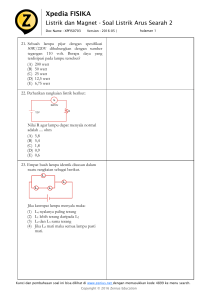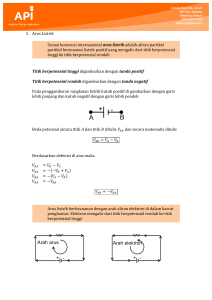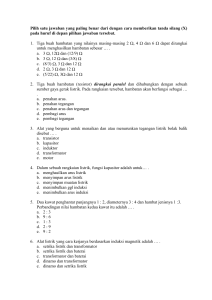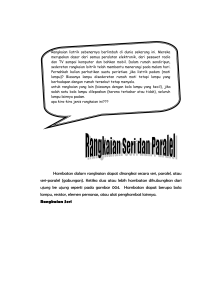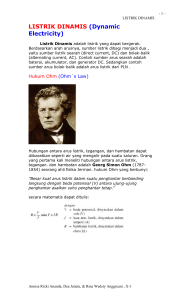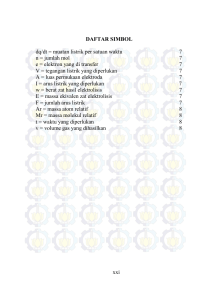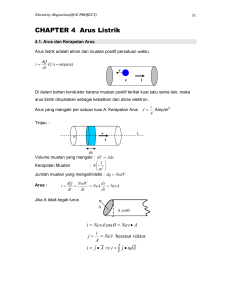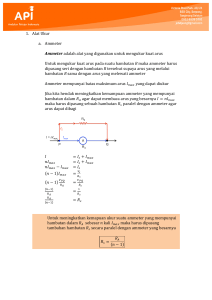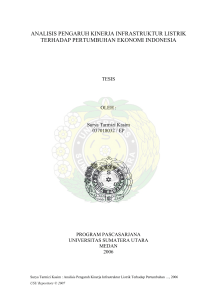File - depur n fisika
advertisement
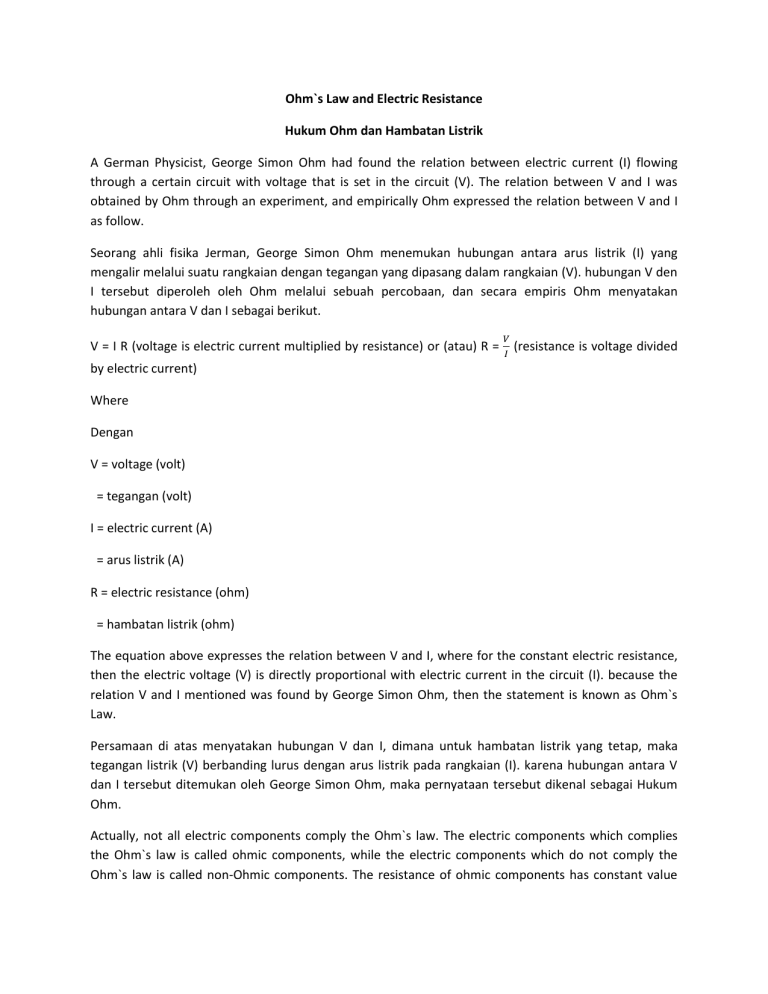
Ohm`s Law and Electric Resistance Hukum Ohm dan Hambatan Listrik A German Physicist, George Simon Ohm had found the relation between electric current (I) flowing through a certain circuit with voltage that is set in the circuit (V). The relation between V and I was obtained by Ohm through an experiment, and empirically Ohm expressed the relation between V and I as follow. Seorang ahli fisika Jerman, George Simon Ohm menemukan hubungan antara arus listrik (I) yang mengalir melalui suatu rangkaian dengan tegangan yang dipasang dalam rangkaian (V). hubungan V den I tersebut diperoleh oleh Ohm melalui sebuah percobaan, dan secara empiris Ohm menyatakan hubungan antara V dan I sebagai berikut. V = I R (voltage is electric current multiplied by resistance) or (atau) R = 𝑉 𝐼 (resistance is voltage divided by electric current) Where Dengan V = voltage (volt) = tegangan (volt) I = electric current (A) = arus listrik (A) R = electric resistance (ohm) = hambatan listrik (ohm) The equation above expresses the relation between V and I, where for the constant electric resistance, then the electric voltage (V) is directly proportional with electric current in the circuit (I). because the relation V and I mentioned was found by George Simon Ohm, then the statement is known as Ohm`s Law. Persamaan di atas menyatakan hubungan V dan I, dimana untuk hambatan listrik yang tetap, maka tegangan listrik (V) berbanding lurus dengan arus listrik pada rangkaian (I). karena hubungan antara V dan I tersebut ditemukan oleh George Simon Ohm, maka pernyataan tersebut dikenal sebagai Hukum Ohm. Actually, not all electric components comply the Ohm`s law. The electric components which complies the Ohm`s law is called ohmic components, while the electric components which do not comply the Ohm`s law is called non-Ohmic components. The resistance of ohmic components has constant value although the voltage is changing,but the resistance of non-ohmic component has the changing value when the voltage is changing. Pada kenyataannya, tidak semua komponen listrik memenuhi hukum Ohm. Komponen – komponen listrik yang memenuhi hukum Ohm disebut komponen ohmik sedangkan komponen – komponen listrik yang tidak memenuhi hukum Ohm disebut komponen non-ohmik. Hambatan komponen ohmik mempunyai nilai tetap meskipun tegangan berubah, tetapi hambatan komponen non-ohmik mempunyai nilai yang berubah ketika tegangan berubah. Electric resistance is the property of any object or substance to resist or oppose the flow of electric current. The quantity of resistance in an electric circuit determines the amount of current slowing in the circuit for any given voltage applied to the circuit, and according to Ohm`s law principle. Hambatan listrik merupakan sifat suatu benda atau bahan untuk menahan atau menentang aliran arus listrik. Besarnya hambatan pada sebuah rangkaian listrik menentukan jumlah aliran arus pada rangkaian untuk setiap tegangan yang diberikan pada rangkaian dan sesuai dengan prinsip hukum Ohm. In either electric circuits or electronic circuits, the value of electric current flowing through a circuit can be controlled using a component called resistor. Resistor is a component made of conductor substances and has a certain value of resistance. Dalam rangkaian listrik maupun rangkaian elektronika, nilai arus listrik yang mengalir melalui suatu rangkaian dapat diatur dengan menggunakan suatu komponen yang disebut resistor. Resistor merupakan sebuah komponen yang dibuat dari bahan konduktor dan mempunyai nilai hambatan tertentu. Basically the resistance value of a certain conductor substance depends on the length, section area, and resistivity of the substance. Mathematically the resistance of a certain conductor substance can be determined by the equation as follow. Pada dasarnya nilai hambatan suatu bahan konduktor bergantung pada panjang, luas penampang dan hambatan jenis bahan tersebut. Secara matematis hambatan suatu bahan konduktor dapat ditentukan dengan persamaan sebagai berikut. ℓ R = 𝜌 𝐴 ( resistance is resistivity multiplied by length of substance divided by area of substance) Where Dengan R = resistance of substance (Ohm) = hambatan bahan (ohm) 𝜌 = resistivity (Ω 𝑚 ) = hambatan jenis bahan(Ω 𝑚 ) ℓ = length of substance (m) = panjang bahan (m) A = section area of substance (m2) = luas penampang bahan (m2) In physics the resistivity, is often related with conductivity, where Dalam fisika hambatan jenis, seringkali dihubungkan dngan konduktivitas bahan, dimana 1 𝜏 = 𝜌 (conductivity of substance is one divided by resistivity) Where Dengan 𝜏 =conductivity of substance (Ω 𝑚 )-1 = konduktivitas bahan (Ω 𝑚 )-1 𝜌 = resistivity of substance (Ω 𝑚 ) = hambatan jenis bahan(Ω 𝑚 ) Resistivity and conductivity of a certain substance is the property of the substance which is not influenced by size and form of the substance, but influenced by the change of temperature. At limit of a certain change of temperature, then the resistivity of a certain substance complies the equation as follow. Hambatan jenis dan konduktivitas suatu bahan merupakan sifat khas bahan yang tidak dipengaruhi oleh ukuran dan bentuk bahan, tetapi dipengaruhi oleh perubahan suhu. Pada batas perubahan suhu tertentu, maka hambatan jenis suatu bahan memenuhi persamaan sebagai berikut. 𝜌𝑇 = 𝜌0 (1 + Δ𝑇) (resistivity at temperature T is resistivity at temperature To (one plus change of temperature)) 𝜌𝑇 - 𝜌0 = Δ 𝜌 (resistivity at temperature T minus resistivity at temperature To is change of resistivity) Δ𝑇 = T - 𝑇0 (change of temperature is temperature minus the first of temperature) Where Dengan 𝜌 = resistivity at temperature T (Ω 𝑚 ) = hambatan jenis pada suhu T (Ω 𝑚 ) 𝜌0 = resistivity at temperature T0 (Ω 𝑚 ) = hambatan jenis pada suhu T0 (Ω 𝑚 ) 𝛼 = temperature coefficient of resistivity (oC-1) = koefisien suhu hambatan jenis (oC-1) Δ𝑇 = change of temperature (oC) = perubahan suhu (oC) Because the electric resistance (R) is directly proportional with resistivity (𝜌), then holds 𝑅𝑇 = 𝑅0 (1 + Δ𝑇) (resistance at temperature T is resistiance at temperature To (one plus change of temperature)) 𝑅𝑇 - 𝑅0 = Δ 𝑅 (resistance at temperature T minus resistanceat temperature To is change of resistance) The quantity of a from the equations above is called temperature coefficient of resistivity, which depends on the type of substance. Besaran α dari persamaan – persamaan di atas disebut dengan koefisien suhu hambatan jenis, yang bergantung pada jenis bahan. The value of resistivity of a certain substance determines the ability of the substance in the conduct electricity. conductor substances such as aluminum and copper have smaller resistivity compared to isolator substances such as rubber and glass, while the semiconductor substances such as the pure germanium and silicon have the resistivity between the resistivity of conductors and isolators. Nilai hambatan jenis suatu bahan ,menentukan kemampuan bahan tersebut dalam menghantarkan listrik. Bahan konduktor seperti aluminium dan tembaga mempunyai hambatan jenis lebih kecil dari bahan isolator seperti karet dan kaca, sedangkan bahan semikonduktor seperti germanium dan silicon murni tentu mempunyai hambatan jenis diantara hambatan jenis konduktor dan isolator. Sample problem Contoh soal Determine electric current flowing through the wire if it is connected with 3(three) volts voltage and the resistance of wire is constant and with resistance 0,175 (zero point one seven five) ohm? Tentukan arus listrik yang mengalir melalui kawat jika kawat dihubungkan dengan tegangan volt da hambatan kawat tetap dengan hambatan sebesar 0,175 ohm? 𝑉 3 𝑣𝑜𝑙𝑡 I = 𝑅 = 0,175 𝑜ℎ𝑚 = 17,14 ampere (seven ten point one four ampere)
